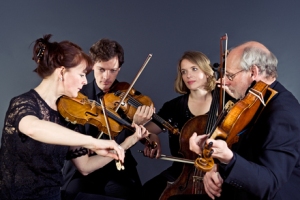Category Archives: FitzwilliamQtet
A meadow in the making
Something the pandemic has shown us is that increasingly people are turning (or re-turning) to nature for inspiration and sustenance at a difficult time. At a different and much broader global scale, nature is taking a more centre stage as countries come together to address the twin crises of biodiversity loss and climate change – the recent G7 meeting and the Climate Change Conference of the Parties (COP26) hosted by the UK in Glasgow in November, are examples of this.
The pandemic has caused a big drive on gardening, and we have jumped on this bandwagon willingly. Our focus has been to try and make a wildflower meadow. Native wildflower grasslands have been lost across England at an alarming rate over the past three or four decades with only 2% of this important wildlife habitat remaining. These places are important not just for the flowers, but also for the pollinating insects they support, and a wide variety of other flora and fauna. They are mini-ecosystems too, offering us a range of services for ‘free’ – capturing carbon, retaining water, improving the soil, not to mention inspiration for art in all its forms.
Our little meadow is in its early stages – its first year in fact. In November 2019 we began to clear deeply rooted scrub, keeping some for habitat mosaic and heterogeneity. In October 2020, (with the help of Sarah and Seth Lord of Native Gardens) wildflower seed, of East Anglian provenance, was sown, and by June it was looking gorgeous with a beautiful range of annual flowers as a nursery crop for the later mix of perennial herbs and sensitive grasses that we are hoping for next year. We have experienced a sea of colour, starting with poppies (red), moving to corn chamomile (white), then cornflower (blue) and finally corn cockle (pink) and corn marigold (yellow). The meadow is bounded by a (failing) hedge of Holly on one side – not all our efforts work at first – and a beech hedge separating us from our neighbours.
The results, so far, are not just about looking nice. We have monitored the wildlife that is using our space, and we use a light-trap to catch moths overnight and identify them the next day before letting them go unharmed – moth diversity is already increasing.
The video below shows the changes we have witnessed over the year. The musical accompaniment is by The Fitzwilliam String Quartet together with Lesley Schatzberger.
FSQ and the Out Hear! Festival @KingsPlace
 On Sunday 19 Jan, Kings Place hosted a the first of a series of concerts in the Out Hear! programme that explores electronics, classical compositions and acoustical elements from leading and upcoming artists within the world of contemporary music. There was a excellent turn out for a winter afternoon, a warm hearted gathering of friends, admirers and the intrigued. The concert attracted a diverse crowd; the oldest being close to 100 years of age, and the youngest, just a day shy of 11. One member of the audience had travelled all the way from San Diego. That is dedication!
On Sunday 19 Jan, Kings Place hosted a the first of a series of concerts in the Out Hear! programme that explores electronics, classical compositions and acoustical elements from leading and upcoming artists within the world of contemporary music. There was a excellent turn out for a winter afternoon, a warm hearted gathering of friends, admirers and the intrigued. The concert attracted a diverse crowd; the oldest being close to 100 years of age, and the youngest, just a day shy of 11. One member of the audience had travelled all the way from San Diego. That is dedication!
The concert was based around three current recording projects of the Fitzwilliam String Quartet. They kicked off with the beautiful and emotionally exuberant first quartet of geologist John Ramsay, written in 2001, inspired by Bartok and folk music of Eastern Europe. This was followed by a fantastic duet for solo violin and live electronics called Iridaceae written in 2002 by Liz Johnson. The piece used 8 speakers around the auditorium to expand the sound of the violin, granulise, pitch shift and multiply 99 times the violin ‘voice’. Wonderful echo’s and undulations were generated as the piece progressed. The music describes the unfurling of Iris petals and the journey from life to death.
The second half included two pieces for saxophone and string quartet, Fantasia 1, Epiphany composed in 2009 and ABSOLUTELY!, composed in 2008, a musical meditation on purity, unselfishness, honesty and love both by Uwe Steinmetz. These pieces are a fabulous blend of jazz and classical music playing. Reviews of the recently released CD can be found here.
A new recording
 This month we are fund raising for a new recording by the Fitzwilliam String Quartet in memory of Bastien. Our target is £8000 to cover, rehearsal, studio and production costs.
This month we are fund raising for a new recording by the Fitzwilliam String Quartet in memory of Bastien. Our target is £8000 to cover, rehearsal, studio and production costs.
The programme is currently under discussion. Proposals include Verdi Quartet in E minor, written in 1873 in the composer’s ‘leisure moments’ and possibly Janacek.
First concert of 2014 at Kings Place
 My father Bastien (view his Guardian obit here), was a great supporter of the Fitzwilliam String Quartet and they regularly rehearsed and performed in my parents London home.
My father Bastien (view his Guardian obit here), was a great supporter of the Fitzwilliam String Quartet and they regularly rehearsed and performed in my parents London home.
The Quartet are playing their first concert of the year on 19 Jan 4pm at Kings Place as part of the ‘Out Hear‘ programme.
The concert will fuse jazz, classical, folk, and electronic music, featuring original compositions by Uwe Steinmetz, Liz Johnson, and Bastien’s great friend, the geologist John Ramsay. The concert will celebrate the release of the recording Absolutely! You can listen to a sample of the music here.
Also included in the concert, will be a short piece written especially for Bastien by Uwe.
Tickets can be booked on line
Later in the year the quartet are performing in Andover, Oxford, Cambridge, Hay on Wye, Cardiff, Newton Abbott, Gloucester, Allendale as well as many concerts in and around London. Here is their schedule of performances.
